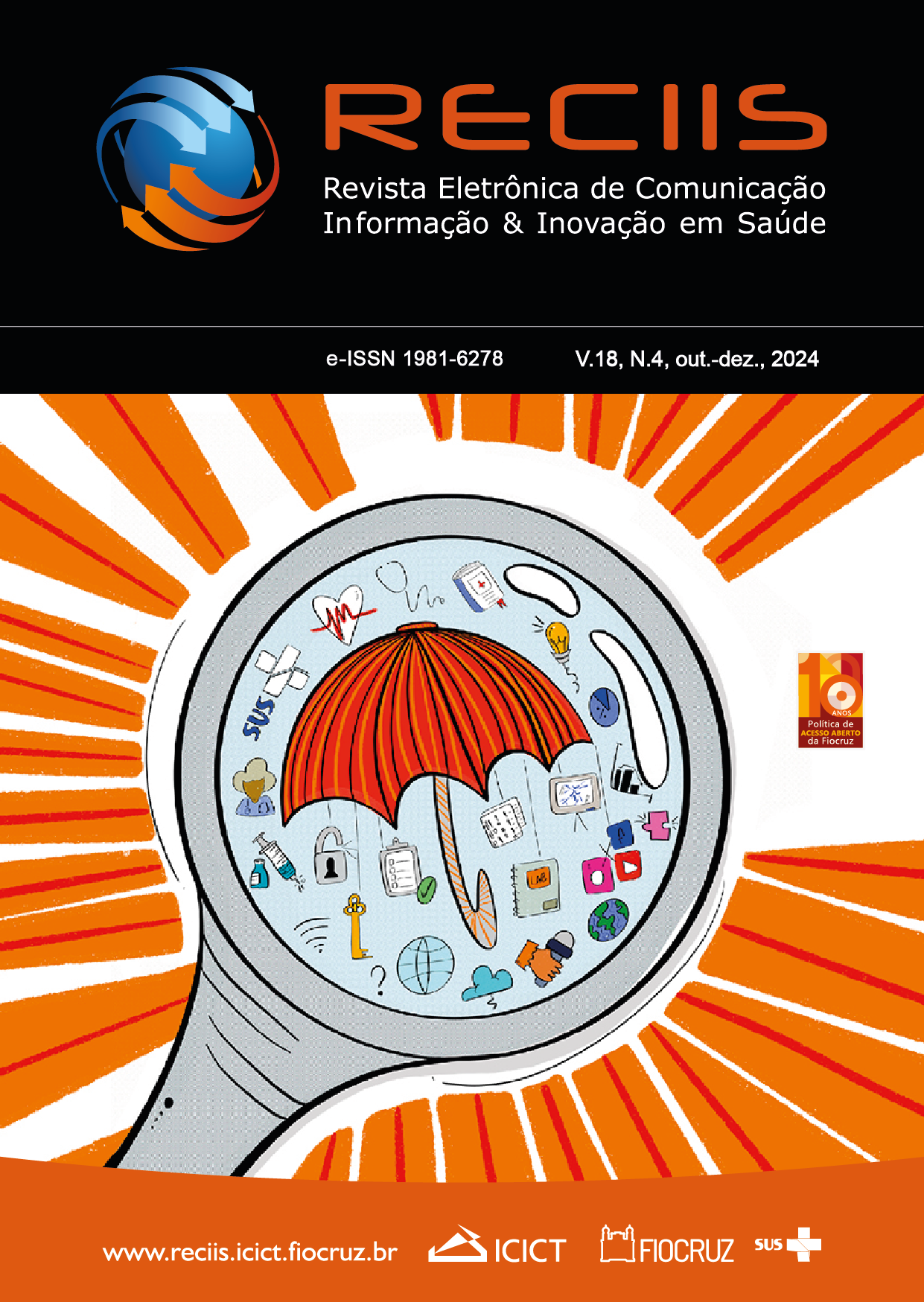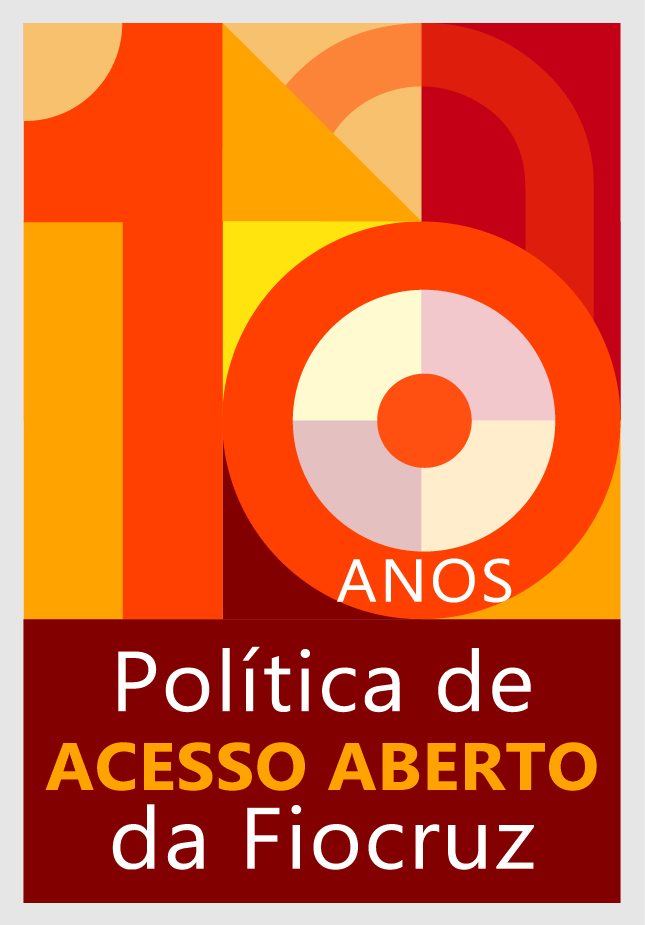Influências do tempo de tela na qualidade de vida infantil
DOI:
https://doi.org/10.29397/reciis.v18i4.4088Palavras-chave:
Mídias audiovisuais, Tempo de tela, Criança, Qualidade de vida, Saúde infantilResumo
Com o aumento do uso de telas na população pediátrica, esta pesquisa objetiva avaliar a influência do padrão de uso e tempo de tela na qualidade de vida infantil. Trata-se de estudo observacional, transversal e analítico realizado com mães, pais e outros responsáveis por crianças em idade pré-escolar (de 2 a 4 anos) em uma cidade do nordeste brasileiro, totalizando 198 crianças. A coleta de dados foi realizada via Google Forms e a qualidade de vida verificada usando o instrumento PedsQL 4.0. A maioria das crianças utiliza as telas por mais de uma hora por dia (69,19%), acima do recomendado pelas entidades médicas. Verificou-se a influência do uso de mídias digitais na qualidade de vida infantil: piores padrões de uso estavam relacionados a prejuízos na saúde física (p=0,012) e emocional (p entre 0,006 e 0,046). O tempo de tela elevado correlacionou-se com impactos na esfera social da vida da criança (p=0,043).
Referências
ABUD, Cristiane Curi; LUCCHESE, Ana Cecilia; ZIMMERMANN, Vera Blondina. A infância: introdução. In: MARCO, Mario Alfredo de et al. Psicologia médica: abordagem integral do processo saúde-doença. Porto Alegre: Artmed, 2012. p. 187-208.
AISHWORIYA, Ramkumar et al. Television viewing and child cognition in a longitudinal birth cohort in Singapore: the role of maternal factors. BMC Pediatrics, London, v. 19, n. 1, p. 1-8, 2019. DOI: https://doi.org/10.1186/s12887-019-1651-z. Disponível em: https://link.springer.com/article/10.1186/s12887-019-1651-z. Acesso em: 20 ago. 2023.
ALI, Reem Ahmad; ALMA’AYTAH, Maha Mohamed Deib. Correlates of parental knowledge about smartphone exposure among young children. Pediatrics International, Carlton South, v. 64, n. 1, 20 maio 2022. DOI: https://doi.org/10.1111/ped.15246. Disponível em: https://onlinelibrary.wiley.com/doi/10.1111/ped.15246. Acesso em: 26 ago. 2024.
BUCHWEITZ, Augusto. Desenvolvimento da linguagem e da leitura no cérebro atualmente: neuromarcadores e o caso de predição. Jornal de Pediatria, Porto Alegre, v. 92, n. 3, p. S8-S13, 2016. DOI: https://doi.org/10.1016/j.jped.2016.01.005. Disponível em: https://www.scielo.br/j/jped/a/QwDnRXppZGXHCzmVTTRFWzN/?lang=pt. Acesso em: 20 ago. 2023.
CENTRO REGIONAL DE ESTUDOS PARA O DESENVOLVIMENTO DA SOCIEDADE DA INFORMAÇÃO (CETIC.BR.). Núcleo de Informação e Coordenação do Ponto BR. Pesquisa TIC Kids Online Brasil 2022. São Paulo: Comitê Gestor da Internet do Brasil, 2023. E-book. Disponível em: https://cetic.br/pt/publicacao/pesquisa-sobre-o-uso-da-internet-por-criancas-e-adolescentes-no-brasil-tic-kids-online-brasil-2022/. Acesso em: 20 ago. 2023.
DESLANDES, Suely Ferreira; COUTINHO, Tiago. The intensive use of the internet by children and adolescents in the context of covid-19 and the risks for self-inflicted violence. Ciência e Saúde Coletiva, Rio de Janeiro, v. 25, p. 2479-2486, 2020. DOI: https://doi.org/10.1590/1413-81232020256.1.11472020. Disponível em: https://www.scielosp.org/article/csc/2020.v25suppl1/2479-2486/en/. Acesso em: 20 ago. 2023.
DOMOFF, Sarah E. et al. A naturalistic study of child and family screen media and mobile device use. Journal of Child and Family Studies, New York, v. 28, n. 2, p. 401-410, 2019. DOI: https://doi.org/10.1007/s10826-018-1275-1. Disponível em: https://link.springer.com/article/10.1007/s10826-018-1275-1. Acesso em: 20 ago. 2023.
DROUIN, Michelle et al. How parents and their children used social media and technology at the beginning of the covid-19 pandemic and associations with anxiety. Cyberpsychology, Behavior, and Social Networking, New Rochelle, v. 23, n. 11, p. 727-736, 2020. DOI: https://doi.org/10.1089/cyber.2020.0284. Disponível em: https://www.liebertpub.com/doi/abs/10.1089/CYBER.2020.0284. Acesso em: 20 ago. 2023.
FELIX, Erika et al. Excessive screen media use in preschoolers is associated with poor motor skills. Cyberpsychology, Behavior, and Social Networking, New Rochelle, v. 23, n. 6, p. 418-425, 2020. DOI: https://doi.org/10.1089/cyber.2019.0238. Disponível em: https://www.liebertpub.com/doi/abs/10.1089/cyber.2019.0238. Acesso em: 20 ago. 2023.
FERNANDES, Claudia Mascarenhas; EISENSTEIN, Evelyn; SILVA, Eduardo Jorge Custódio da. A criança de 0 a 3 anos e o mundo digital. Rio de Janeiro: Sociedade Brasileira de Pediatria, 2018. Disponível em: https://www.sbp.com.br/fileadmin/user_upload/A_CRIANCA_DE_0_A_3_ANOS_E_O_MUNDO_DIGITAL.pdf. Acesso em: 20 ago. 2023.
GUERRERO, Michelle D. et al. Screen time and problem behaviors in children: Exploring the mediating role of sleep duration. International Journal of Behavioral Nutrition and Physical Activity, [London], v. 16, n. 1, p. 1-10, 2019. DOI: https://doi.org/10.1186/s12966-019-0862-x. Disponível em: https://ijbnpa.biomedcentral.com/articles/10.1186/s12966-019-0862-x?fbclid=IwAR1WRGA7htl. Acesso em: 20 ago. 2023.
HUTTON, John S. et al. Associations between screen-based media use and brain white matter integrity in preschool-aged children. JAMA Pediatrics, Chicago, v. 174, n. 1, p. 1-10, 2019. DOI: https://doi.org/10.1001/jamapediatrics.2019.3869. Disponível em: https://jamanetwork.com/journals/jamapediatrics/fullarticle/2754101. Acesso em: 20 ago. 2023.
KERAI, Salima et al. Screen time and developmental health: results from an early childhood study in Canada. BMC Public Health, v. 22, p. 310, 2022. DOI: https://doi.org/10.1186/s12889-022-12701-3. Disponível em: https://bmcpublichealth.biomedcentral.com/articles/10.1186/s12889-022-12701-3. Acesso em: 21 ago. 2024.
KLIEGMAN, Robert M. et al. Nelson Tratado de Pediatria. 20. ed. Rio de Janeiro: Elsevier, 2018.
MADIGAN, Sheri et al. Association between screen time and children’s performance on a developmental screening test. JAMA Pediatrics, Chicago, v. 173, n. 3, p. 244-250, 2019. DOI: https://doi.org/10.1001/jamapediatrics.2018.5056. Disponível em: https://jamanetwork.com/journals/jamapediatrics/article-abstract/2722666. Acesso em: 20 ago. 2023.
MASSARONI, Valentina et al. The relationship between language and technology: how screen time affects language development in early life–a systematic review. Brain Sciences, Basel, v. 14, n. 1, p. 1-19, 2023. DOI: https://doi.org/10.3390/brainsci14010027. Disponível em: https://www.mdpi.com/2076-3425/14/1/27. Acesso em: 21 ago. 2024.
MATA, Ingrid Ribeiro Soares da et al. As implicações da pandemia da covid-19 na saúde mental e no comportamento das crianças. Residência Pediátrica, Rio de Janeiro, v. 10, n. 3, p. 1-5, 2020. Disponível em: https://residenciapediatrica.com.br/detalhes/643/as%20implicacoes%20da%20pandemia%20da%20covid-19%20na%20saude%20mental%20e%20no%20comportamento%20das%20criancas. Acesso em: 20 ago. 2023.
MOREIRA, Larissa Hora et al. Consequências do tempo de tela precoce no desenvolvimento infantil = Consequences of early screen time on child development. Brazilian Journal of Development, Paraná, v. 7, n. 10, p. 97125-97133, 14 out. 2021. DOI: https://doi.org/10.34117/bjdv7n10-156. Disponível em: https://ojs.brazilianjournals.com.br/ojs/index.php/BRJD/article/view/37372. Acesso em: 21 ago. 2024.
MOTAMED-GORJI, Nazgol et al. Association of screen time and physical activity with health-related quality of life in Iranian children and adolescents. Health and Quality of Life Outcomes, [London], v. 17, n. 1, p. 1-11, 2019. DOI: https://doi.org/10.1186/s12955-018-1071-z. Disponível em: https://hqlo.biomedcentral.com/articles/10.1186/s12955-018-1071-z. Acesso em: 20 ago. 2023.
MUNZER, Tiffany G. et al. Media exposure in low-income preschool-aged children is associated with multiple measures of self-regulatory behavior. Journal of Develeopmental Behavioral Pediatrics, Baltimore, v. 39, n. 4, p. 303-309, 2018. DOI: https://doi.org/10.1097/DBP.0000000000000560. Disponível em: https://journals.lww.com/jrnldbp/fulltext/2018/05000/media_exposure_in_low_income_preschool_aged.4.aspx. Acesso em: 20 ago. 2023.
NOBRE, Juliana Nogueira Pontes et al. Determining factors in children’s screen time in early childhood. Ciência e Saúde Coletiva, Rio de Janeiro, v. 26, n. 3, p. 1127-1136, 2021. DOI: https://doi.org/10.1590/1413-81232021263.00602019. Disponível em: https://www.scielo.br/j/csc/a/GmStpKgyqGTtLwgCdQx8NMR/?lang=pt. Acesso em: 30 out. 2024.
ORGANIZAÇÃO MUNDIAL DA SAÚDE (OMS). Diretrizes da atividade física, comportamento sedentário e sono para crianças com menos de 5 anos de idade. Tradução: Edina Maria de Camargo e Ciro Romelio Rodriguez Añez. [Genebra]: OMS, 2020. Disponível em: https://iris.who.int/bitstream/handle/10665/311664/9786500208764-por.pdf?sequence=61. Acesso em: 20 ago. 2023.
POULAIN, Tanja et al. Media use of mothers, media use of children, and parent–child interaction are related to behavioral difficulties and strengths of children. International Journal of Environmental Research and Public Health, Basel, v. 16, n. 23, 2019. DOI: https://doi.org/10.3390/ijerph16234651. Disponível em: https://www.mdpi.com/1660-4601/16/23/4651. Acesso em: 20 ago. 2023.
R CORE TEAM. R: a language and environment for statistical computing. Vienna, Austria: R Foundation for Statistical Computing, 2023.
SINA, Elida et al. Digital media exposure and cognitive functioning in European children and adolescents of the I.Family study. Scientific Reports, London, v. 13, p. 18855, 2023. DOI: https://doi.org/10.1038/s41598-023-45944-0. Disponível em: https://www.nature.com/articles/s41598-023-45944-0. Acesso em: 21 ago. 2024.
SKALICKÁ, Věra et al. Screen time and the development of emotion understanding from age 4 to age 8: a community study. British Journal of Developmental Psychology, Leicester, v. 37, n. 3, p. 427-443, 2019. DOI: https://doi.org/10.1111/bjdp.12283. Disponível em: https://bpspsychub.onlinelibrary.wiley.com/doi/abs/10.1111/bjdp.12283. Acesso em: 20 ago. 2023.
SOCIEDADE BRASILEIRA DE PEDIATRIA (SBP). Departamento de Adolescência. Manual de orientação: saúde de crianças e adolescentes na era digital. [Rio de Janeiro]: SBP, 2016. Disponível em: https://www.sbp.com.br/fileadmin/user_upload/2016/11/19166d-MOrient-Saude-Crian-e-Adolesc.pdf. Acesso em: 20 ago. 2023.
SOCIEDADE BRASILEIRA DE PEDIATRIA (SBP). Grupo de Trabalho Saúde na Era Digital. Manual de orientação: #Menos Telas #Mais Saúde. [Rio de Janeiro]: SBP, 2019. Disponível em: https://www.sbp.com.br/fileadmin/user_upload/_22246c-ManOrient_-__MenosTelas__MaisSaude.pdf. Acesso em: 20 ago. 2023.
SOCIEDADE BRASILEIRA DE PEDIATRIA (SBP). Grupo de Trabalho Saúde na Era Digital (2019-2021). Recomendações sobre o uso saudável das telas digitais em tempos de pandemia da covid-19 #Boas Telas #Mais Saúde. [Rio de Janeiro]: SBP, 2020. Disponível em: https://www.sbp.com.br/fileadmin/user_upload/22521b-NA_Recom_UsoSaudavel_TelasDigit_COVID19__BoasTelas__MaisSaude.pdf. Acesso em: 20 ago. 2023.
TOOTH, Leigh et al. How adherence to Australian screen time guidelines differs by age in Australian children aged 0 to 12 years. The Medical Journal of Australia, Sydney, v. 211, n. 4, p. 181-182, 2019. DOI: https://doi.org/10.5694/mja2.50286. Disponível em: https://onlinelibrary.wiley.com/doi/full/10.5694/mja2.50286. Acesso em: 20 ago. 2023.
TOOTH, Leigh R.; MOSS, Katrina M.; MISHRA, Gita D. Screen time and child behaviour and health-related quality of life: effect of family context. Preventive Medicine, New York, v. 153, p. 106795, 2021. DOI: https://doi.org/10.1016/j.ypmed.2021.106795. Disponível em: https://www.sciencedirect.com/science/article/abs/pii/S0091743521003649. Acesso em: 20 ago. 2023.
TRINH, Mai Han et al. Association of trajectory and covariates of children’s screen media time. JAMA Pediatrics, Chicago, v. 174, n. 1, p. 71-78, 2019. DOI: https://doi.org/10.1001/jamapediatrics.2019.4488. Disponível em: https://jamanetwork.com/journals/jamapediatrics/article-abstract/2755656. Acesso em: 20 ago. 2023.
VARNI, James W. PedsQL Pediatric Quality of Life Inventory. [S. l.]: James W. Varni, 2022. Disponível em: https://www.pedsql.org/index.html. Acesso em: 6 jan. 2022.
Downloads
Publicado
Como Citar
Edição
Seção
Licença
Copyright (c) 2024 Beatriz Andrade Vasconcelos, Antonia Iracilda e Silva Viana

Este trabalho está licenciado sob uma licença Creative Commons Attribution-NonCommercial 4.0 International License.
Direitos de autor: O autor retém, sem restrições dos direitos sobre sua obra.
Direitos de reutilização: A Reciis adota a Licença Creative Commons, CC BY-NC atribuição não comercial conforme a Política de Acesso Aberto ao Conhecimento da Fundação Oswaldo Cruz. Com essa licença é permitido acessar, baixar (download), copiar, imprimir, compartilhar, reutilizar e distribuir os artigos, desde que para uso não comercial e com a citação da fonte, conferindo os devidos créditos de autoria e menção à Reciis. Nesses casos, nenhuma permissão é necessária por parte dos autores ou dos editores.
Direitos de depósito dos autores/autoarquivamento: Os autores são estimulados a realizarem o depósito em repositórios institucionais da versão publicada com o link do seu artigo na Reciis.












